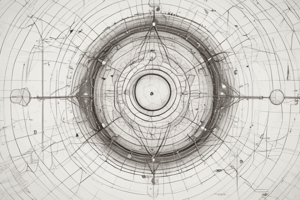Podcast
Questions and Answers
What operation combines two or more vectors to form a new vector?
What operation combines two or more vectors to form a new vector?
- Addition (correct)
- Multiplication
- Division
- Subtraction
In the head-to-tail method of vector addition, where does the resulting vector start and end?
In the head-to-tail method of vector addition, where does the resulting vector start and end?
- Starts at the tail of the first vector and ends at the tip of the last vector (correct)
- Starts at the tail of the last vector and ends at the tip of the first vector
- Starts at the head of the first vector and ends at the tail of the last vector
- Starts at the tip of the first vector and ends at the tip of the second vector
How is the vector sum calculated in the parallelogram law?
How is the vector sum calculated in the parallelogram law?
- By finding the diagonal of the parallelogram formed by the two vectors (correct)
- By multiplying the two vectors
- By taking the average of the two vectors
- By dividing one vector by another
What does vector projection measure?
What does vector projection measure?
Which operation finds a third vector perpendicular to both input vectors?
Which operation finds a third vector perpendicular to both input vectors?
What is another term for the dot product?
What is another term for the dot product?
In which method are vectors added directly to each other to create a triangle?
In which method are vectors added directly to each other to create a triangle?
What is achieved through the dot product operation?
What is achieved through the dot product operation?
Flashcards are hidden until you start studying
Study Notes
Vector Math
Vector Addition
Vector addition is the operation of combining two or more vectors to form a new vector. Two methods are commonly used to add vectors: the head-to-tail method and the parallelogram law.
Head-To-Tail Method
In the head-to-tail method, the vectors are added directly to each other, creating a new vector that starts at the tail of the first vector and ends at the tip of the last vector. This process creates a triangle, and the resulting vector is usually referred to as the 'sum' or the 'resultant'.
Parallelogram Law
Alternatively, the parallelogram law states that if two vectors are placed with their initial points coinciding, the vector sum will be the diagonal of the parallelogram formed by the two vectors.
Vector Projection
Vector projection refers to the operation of finding the projection of one vector onto another vector. It measures the amount of one vector that lies in the direction of another vector. The projection of one vector onto another can be achieved through the dot product.
Cross Product
The cross product is a binary operation that takes two vectors and produces a third vector perpendicular to both of them. This operation is primarily used in determining area, volume, and orientation.
Dot Product
The dot product, also known as the scalar product or simply the product, is a scalar value that results when two vectors are multiplied together. The dot product gives information about the magnitudes and directions of the vectors involved.
Vector Spaces
A vector space is a set of vectors, equipped with operations of vector addition and scalar multiplication, and satisfying certain axioms. Vector spaces have many applications in mathematics, physics, and engineering. They provide a framework for representing and manipulating complex systems in a structured and systematic way.
Angle
Two vectors are said to be orthogonal (or perpendicular) if their angles with respect to each other measure 90 degrees. When two vectors are orthogonal, their dot product equals zero.
Studying That Suits You
Use AI to generate personalized quizzes and flashcards to suit your learning preferences.




